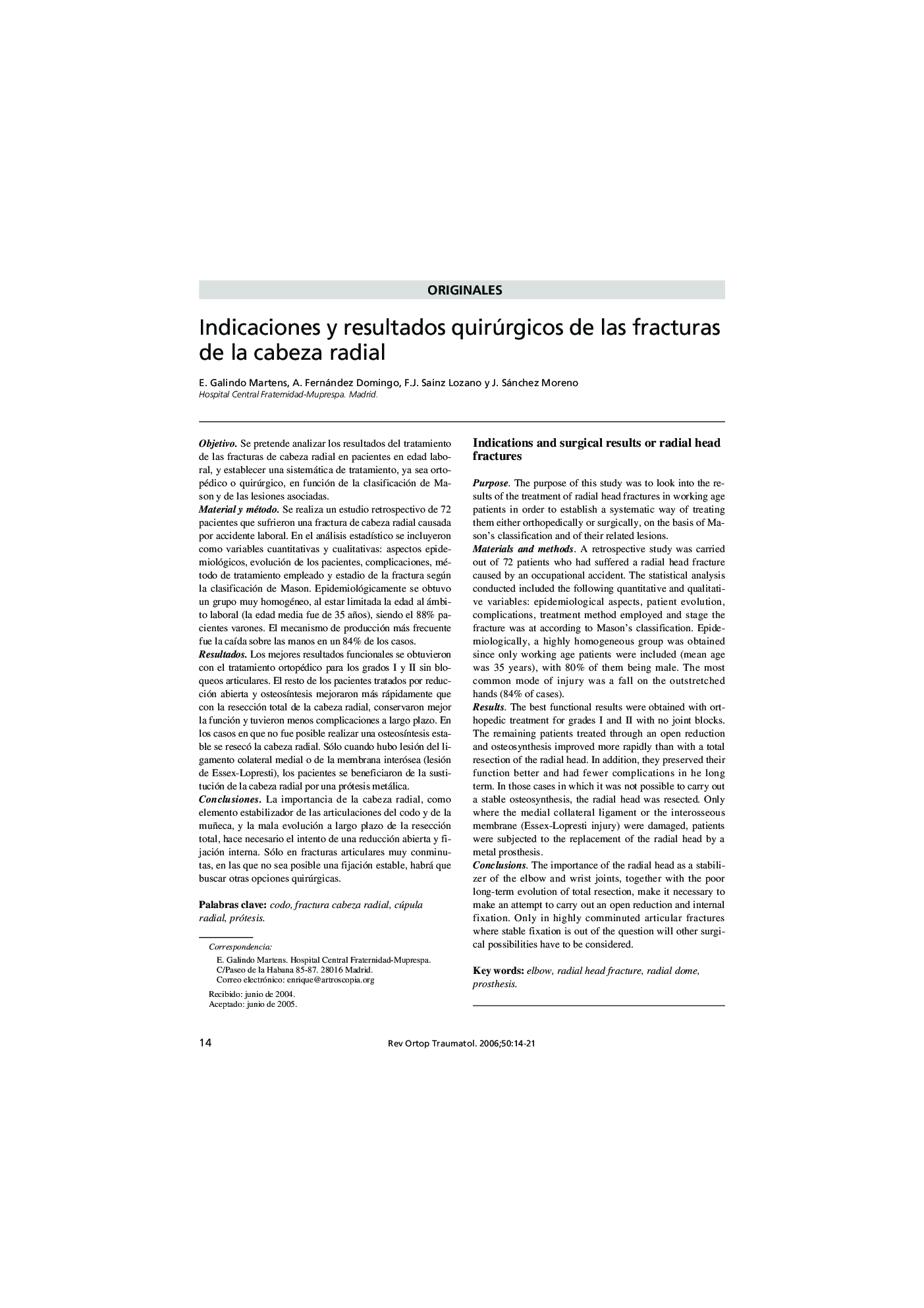| Article ID | Journal | Published Year | Pages | File Type |
|---|---|---|---|---|
| 4088136 | Revista de Ortopedia y Traumatología | 2006 | 8 Pages |
ObjetivoSe pretende analizar los resultados del tratamiento de las fracturas de cabeza radial en pacientes en edad laboral, y establecer una sistemática de tratamiento, ya sea ortopédico o quirúrgico, en función de la clasificación de Mason y de las lesiones asociadas.Material y métodoSe realiza un estudio retrospectivo de 72 pacientes que sufrieron una fractura de cabeza radial causada por accidente laboral. En el análisis estadístico se incluyeron como variables cuantitativas y cualitativas: aspectos epidemiológicos, evolución de los pacientes, complicaciones, método de tratamiento empleado y estadio de la fractura según la clasificación de Mason. Epidemiológicamente se obtuvo un grupo muy homogéneo, al estar limitada la edad al ámbito laboral (la edad media fue de 35 años), siendo el 88% pacientes varones. El mecanismo de producción más frecuente fue la caída sobre las manos en un 84% de los casos.ResultadosLos mejores resultados funcionales se obtuvieron con el tratamiento ortopédico para los grados I y II sin bloqueos articulares. El resto de los pacientes tratados por reducción abierta y osteosíntesis mejoraron más rápidamente que con la resección total de la cabeza radial, conservaron major la función y tuvieron menos complicaciones a largo plazo. En los casos en que no fue posible realizar una osteosíntesis estable se resecó la cabeza radial. Sólo cuando hubo lesión del ligamento colateral medial o de la membrana interósea (lesion de Essex-Lopresti), los pacientes se beneficiaron de la sustitución de la cabeza radial por una prótesis metálica.ConclusionesLa importancia de la cabeza radial, como elemento estabilizador de las articulaciones del codo y de la muñeca, y la mala evolución a largo plazo de la resección total, hace necesario el intento de una reducción abierta y fijación interna. Sólo en fracturas articulares muy conminutas, en las que no sea posible una fijación estable, habrá que buscar otras opciones quirúrgicas.
PurposeThe purpose of this study was to look into the results of the treatment of radial head fractures in working age patients in order to establish a systematic way of treating them either orthopedically or surgically, on the basis of Mason's classification and of their related lesions.Materials and methodsA retrospective study was carried out of 72 patients who had suffered a radial head fracture caused by an occupational accident. The statistical analysis conducted included the following quantitative and qualitative variables: epidemiological aspects, patient evolution, complications, treatment method employed and stage the fracture was at according to Mason's classification. Epidemiologically, a highly homogeneous group was obtained since only working age patients were included (mean age was 35 years), with 80% of them being male. The most common mode of injury was a fall on the outstretched hands (84% of cases).ResultsThe best functional results were obtained with orthopedic treatment for grades I and II with no joint blocks. The remaining patients treated through an open reduction and osteosynthesis improved more rapidly than with a total resection of the radial head. In addition, they preserved their function better and had fewer complications in he long term. In those cases in which it was not possible to carry out a stable osteosynthesis, the radial head was resected. Only where the medial collateral ligament or the interosseous membrane (Essex-Lopresti injury) were damaged, patients were subjected to the replacement of the radial head by a metal prosthesis.ConclusionsThe importance of the radial head as a stabilizer of the elbow and wrist joints, together with the poor long-term evolution of total resection, make it necessary to make an attempt to carry out an open reduction and internal fixation. Only in highly comminuted articular fractures where stable fixation is out of the question will other surgical possibilities have to be considered.
